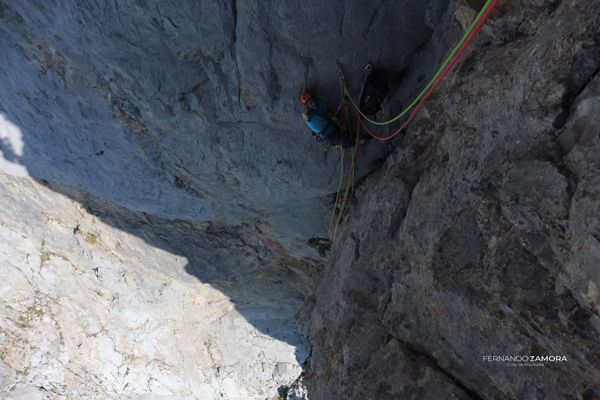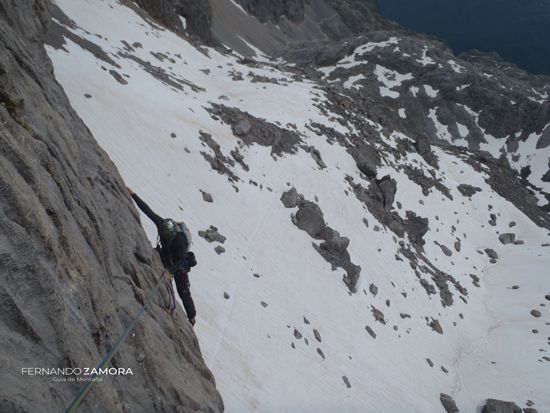In terms of difficulty, the Chico Problemático route in Horcados Rojos would be, in the natural evolution of climbers in the area, the next step up from Rojo Libanés. Although it is not as classic as this one, Chico Problemático is already becoming a reference in its style not only in Horcados Rojos, but also in the whole of Picos de Europa.
Sometimes it is hard to look back, but on this route it is almost obligatory to imagine a young Javier Sáenz elegantly opening the first three pitches alone, setting styles that today, more than thirty years later, is a reference for every meticulous climber.
Really beautiful climbing, sustained pitches, exceptional rock in the most difficult sections and with the unmistakable seal of quality of the openers. Even if not very exposed and with good hand holds, it forces you to climb, so it's advisable to feel comfortable in this grade.
The route is now restored. All spits have been replaced by 10x90mm stainless steel bolts and cordelettess (see handwritten sketch).
The timetable of the Fuente Dé cable car during low season (from 10 am to 6 pm from mid-September to July) makes it necessary not to waste a minute to avoid missing it and having to walk down the Jenduda couloir. Another option is to sleep in the bivouac cave at the foot of the route and climb another route in the area the next day.
Chico Problemático in Horcados Rojos. Route description:
- The first pitch starts in a kind of dihedral-couloir a few metres to the left of the bivouac cave. There's a rock tunnel that can be used to set up belay station 0. The rock isn't very good in this pitch, but still better than it looks at first. You'll need to move around to find the easiest route.
- The second pitch starts to the right of the belay station on a section of difficult protection and not very good rock. Then we get to an exceptional rock section that leads us to a beautiful flake-dihedral.
- The third pitch: shortly after the start there is a section that is not very difficult but where you have to use your head more than your fingers. After that, the difficulty increases but you will find more anchors. The total pitch seems to us to be somewhat tight in terms of grade. Although it has an exposed section, it is one of the best pitches I have climbed in Picos de Europa.
- The fourth pitch is easy, but it is advisable not to get misled on the route (see sketch).
- The fifth pitch is beautiful, consisting of a dihedral with very good rock except for a short section where you have to pay attention. It's easy to protect using friends and with the pitons and rock tunnels already in place. Belay station using two pitons. A Camalot nº4 can be useful at the beginning of the pitch but is not essential.
- Finally, the last pitch of about 60m ends in a grade IV or V couloir where the difficulty decreases as you ascend, and where you have to pay attention to the rocks in the final stretch. Belay station using friends.
FACT SHEET
LENGTH
DIFFICULTY
DURATION
EQUIPMENT
DESCENT
FIRST ASCENT











